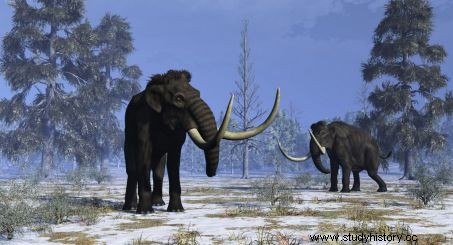Discovery of a monumental structure made of mammoth bones in Russia. 25,000 years old, it would be the oldest known.

A vast circular structure made of mammoth bones, 25,000 years old, was discovered 500 km south of Moscow, Russia.
A circle 12.5m in diameter, made up of massive skulls and large white bones taken from more than 60 woolly mammoths (Mammuthus primigenius) … This is the real ossuary, made up of a stack of ribs, jaws, vertebrae, tusks and other shoulder blades that researchers from the University of Exeter (Great Britain) have just unearthed on the banks of the Don, 70 km south of Voronezh (Russia). Their study is detailed in the journal Antiquity. It stipulates that this vast structure, dated 25,000 years, is contemporary with the groups of hunter-gatherers who evolved in the steppe during the glacial maximum, the period which characterizes the end of the Pleistocene.
This accumulation - on which the archaeologists advanced like on eggs so much they feared to move, break or damage the bones - was cleared about twenty meters from a museum where two "huts" in bones were discovered in the 1950s. These are much smaller than the one that has just been found, which went unnoticed for a long time due to the presence of a small birch wood that had taken root there. This architecture is indeed on the edge of the famous site of Kostenki ("little bone" in Russian), a prehistoric site renowned for its habitats made of mammoth bones, as well as for its Venuses, female statuettes carved in the ivory of the tusks of these extinct proboscids.
A circle 12.5m in diameter, made up of massive skulls and large white bones collected from over 60 woolly mammoths (Mammuthus primigenius) … This is the real ossuary, made up of a stack of ribs, jaws, vertebrae, tusks and other shoulder blades that researchers from the University of Exeter (Great Britain) have just unearthed on the banks of the Don, 70 km south of Voronezh (Russia). Their study is detailed in the journal Antiquity. It stipulates that this vast structure, dated 25,000 years, is contemporary with the groups of hunter-gatherers who evolved in the steppe during the glacial maximum, the period which characterizes the end of the Pleistocene.
This accumulation - on which the archaeologists advanced like on eggs so much they feared to move, break or damage the bones - was cleared about twenty meters from a museum where two "huts" in bones were discovered in the 1950s. These are much smaller than the one that has just been found, which went unnoticed for a long time due to the presence of a small birch wood that had taken root there. This architecture is indeed on the edge of the famous site of Kostenki ("little bone" in Russian), a prehistoric site renowned for its habitats made of mammoth bones, as well as for its Venuses, female statuettes carved in the ivory of the tusks of these extinct proboscids.
 This Kostenki 11 fossil pile was once a giant structure made from the bones of Ice Age mammoths. ©Alexander Pryor
This Kostenki 11 fossil pile was once a giant structure made from the bones of Ice Age mammoths. ©Alexander Pryor
"Kostenki 11", the new site, has thus joined the set of constructions of the great "mammoth steppe" where these herbivores lived en masse in the Upper Palaeolithic. 70 of these structures have been counted throughout Eastern Europe, notably in Mezhyrich, in the Dnieper basin, in Ukraine, as well as in Moravia, the Czech Republic and southern Poland.
 Archaeological excavations of a mammoth bone dwelling in Mezhyrich, Ukraine, in 1966. ©Public domain
Archaeological excavations of a mammoth bone dwelling in Mezhyrich, Ukraine, in 1966. ©Public domain
This new Russian site is particularly attracting the attention of specialists because of its dimensions, which make it one of the largest exhumed mammoth bone achievements. Remarkably preserved, this bone assembly concealed inside traces of wood fire with nearly 400 fragments of charcoal coming mainly from conifers. It also contained hundreds of bones, also used as fuel. So many clues that show that this vast bone shelter served as a refuge during harsh winters, when temperatures dropped below -20°C.
But did he have another role? "Its occupation appears to have been short-lived, raising questions about the real function of this construction which required a considerable investment of time and energy explains Alexander Pryor, the lead author of the study. Among the hypotheses stated:this place could have been used as a hunting shelter, a ceremonial site, or even a food storage warehouse. Specialists believe that the hunter-gatherers of Kostenki probably recovered to build it the massive carcasses of mammoths killed during hunts. They would then have stored the meat and fat in the permafrost, inside three pits dug around the structure, to cope with the rigors of the steppe.
 Woolly mammoths (Mammuthus primigenius) lived from 120,000 to 4,000 years ago for the very last. ©Raul Lunia /Leemage / AFP
Woolly mammoths (Mammuthus primigenius) lived from 120,000 to 4,000 years ago for the very last. ©Raul Lunia /Leemage / AFP
Kept in the tight mesh of the bones, plant remains were also recovered. These were the subject of fine analyzes after their recovery by flotation, a method which consists in using water and sieves to collect by filtering the archaeological material of small size, (plant waste, bone splinters, etc. .). The elements thus collected indicate that its occupants also ate food of plant origin, roots and edible tubers. Valuable information on the dietary adaptation of Paleolithic men who circulated in these icy regions. "Previous research had tended to focus only on structural aspects:bones, pits... At Kostenki 11, we focused on the remains carefully collected by sediment screening and, for the first time , we are beginning to learn more about little explored aspects of human activity in these sites ", continues Alexander Pryor, responding to the Spanish daily La Vanguardia.
